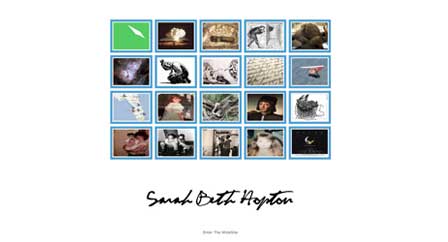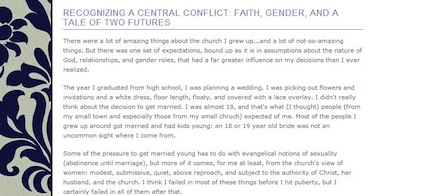Our [Electrate] Stories
Explicating Ulmer's Mystory Genre
Marc C. Santos, Ella R. Bieze, Lauren E. Cagle, Jason C., Zachary P. Dixon, Kristen N. Gay, Sarah Beth Hopton, Megan M. McIntyre
Introduction
“[...] Avatar must not only be understood, but undergone” (Ulmer, 2012, p. xvii)
This webtext details seven graduate students’ experiences with Gregory L. Ulmer’s (2003) Internet Invention, a textbook geared for inventing methodologies and values for our new, digital era. Students enrolled in a New Media Production graduate seminar at the University of South Florida were given 9 weeks to complete Ulmer's “mystory” project, Internet Invention’s major assignment composed of 4 units: career, family, entertainment, and community. Each unit asks students to explore elements of their selves in relation to its discursive domain in order to recognize how the discourse contributes to their perspectives, ambitions, and values.[1] Kenneth Burke (1984) reminded us in Permanence and Change how “a way of seeing is also a way of not seeing” (p. 49); the mystory reveals to us the ways in which different discursive networks influence what we do and do not see.
Ulmer, working from the premises of apparatus theory, identifies our current age as the age of electracy.[2] For Ulmer, communicative technologies are not merely tools we use, but powerful ideological agents that influence (though not necessarily determine) who we are, shaping our identities, desires, and the horizons of what we consider possible. The third major technological epoch in human history, following orality and literacy, electracy traces its roots as far back as the inventions of the photograph, telegraph, and radio, but only begins to realize its full potential after the proliferation of the World Wide Web.
Ulmer first introduced the mystory genre in Teletheory (1989), 15 years before the publication of Internet Invention (2003) and before the proliferation of the Web. Teletheory sought to rethink video composition and production, producing for electracy what the essay was for literacy (Ulmer, 1989, p. ix). Ulmer proposed that if literacy developed an investment in logic and critical thinking, then electracy, given its visual and aural impact and immediacy, would develop an increased appreciation for affect and emotion. Ulmer supported this hypothesis by aligning electracy with psychoanalytic, postmodern, poststructuralist, and feminist challenges to Modernity, Reason, Rationality, and Truth. Drawing upon a wide range of theorists, including Sigmund Freud, Jacques Derrida, Roland Barthes, Rosalie Colie, Teresa de Lauretis, Jean-François Lyotard, and many others, Ulmer (1989) framed the development of his project as a move from history, to herstory, to mystery, to mystory (pp. 82-89). In essence, the mystory is an attempt to put psychoanalytic, postmodern, poststructuralist, and feminist theories to work in service of an electrate rather than literate agenda. Ulmer (1989) explained at length:
The emergence of a regionalized epistemology, the dysfunctioning of the grand explicating metanarratives, and the effectiveness of feminist appeals to personal experience are among the trends encouraging the development of the mystory—a term designating the nexus of history, politics, language, thought, and technology in the last decade of the new millenium. The mystorical approach to a topic such as the future of academic discourse involves a reworking of certain ancient problems—the relation of the particular and the general, the reality of change, the invention of the subject, to name a few. (p. 82)
The purpose of a mystory is to discover rather than to argue, to feel rather than to know. “Electronic thinking does not abandon, exclude, or replace analytic thinking; it puts it in its place in a larger system of reasoning” (Ulmer, 1989, p. 66). Ulmer (1989) asserted that a mystory is not an attempt “to predict, assert, or attack” (p. 86); rather, “it includes an assertion of comprehension that has more in common with the manifesto than with the essay” (1989, p. 90). We will further explicate this distinction in the next section.
In both Teletheory and Internet Invention, and in two other more recent works, Electronic Monuments (2005) and Avatar Emergency (2012), Ulmer argued that scholars have been slow to recognize the need for and to participate in the invention of electrate institutions. Instead, many scholars have worked to conform electrate technologies to the aims of literacy. Such skeuomorphic grafting prevents the academic institution from realizing the inventive potential of new media.[3] An early example of this might be the eBook, which attempts to replicate the organization and conventions of literate technologies (such that endnotes become hyperlinks). A more recent example of this would be Wikipedia, which leverages digital affordances to realize Modern, literate ambitions—the collection of all human knowledge. These projects might be productive, but they do not fulfill Ulmer's goals—to imagine how a new technology might lead to new conceptions and practices.
Of course, Ulmer is not alone in this view—others, such as Sarah J. Arroyo (2005), Colin G. Brooke (2009), and Geoffrey Sirc (2010), have stressed the extent to which rhetoric and composition has overlooked the advantages of digital affordances and remained tied to the printed page. Jan Rune Holmevik (2012), in his explication of Ulmer’s electracy, noted that terms such as digital literacy can be read nefariously as “attempts to name and relegate new digital media forms as subjugated practices to the old print media discourses and its established institutions” (p. 4). Ulmer expanded the argument offered by Jacques Derrida in Of Grammatology (1997) and Paper Machines (2005); the preferencing of speech over writing is to Derrida what the preferencing of writing over electracy is to Ulmer. What is unique to Ulmer’s work is the extent to which he proposes a new curriculum and pedagogy to realize his digital ambitions. This webtext documents one graduate class’s work with those ambitions—testing the aspirations, highlighting the successes, and documenting the struggles that Ulmer’s electrate pedagogy offers rhetoric and composition.
In the next section, Electracy, we further explicate Ulmer’s concept of electracy and identify the core goals of the mystory, exploring its complicated, postpedagogical connections to James Berlin’s (1988) characterizations of expressivism and social-epistemic rhetoric. While the primary aim of this webtext concerns pedagogic implementation, it is difficult to grasp the pedagogic challenges the mystory presents without understanding its ideological aims and Ulmer’s deep commitment to Derridean notions of deconstruction, iterability, and risk. It resists the kind of authoritarian impulse silently hidden in social-epistemic rhetoric while eschewing the a-social isolation Berlin condemns in expressivism. Because Ulmer’s mystory lays the ethical, deconstructive groundwork for agonistic, political action, our electracy section concludes by aligning the mystory with contemporary rhetorical projects centered around the prioritization of the other.
The subsequent sections synthesize the perspectives of seven different graduate students regarding their experiences with the mystory genre. Those students serve as co-authors of this article; they have each responded to a seven question postmortem that dissects the successes and challenges of the mystory and worked together to synthesize their responses. In the article’s final section, Marc C. Santos responds to the student observations. Collectively, the article provides an overview of expectations for other instructors and students who might choose to experiment with Ulmer’s electrate pedagogy.





